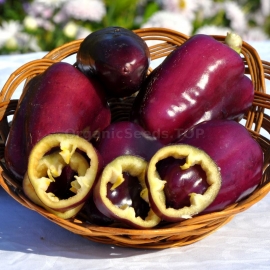
«Purple Beauty» - Organic Pepper Seeds
1.14 €
Purple Beauty pepper seeds produce compact, bushy plants with thick protective foliage. The fruits begin to form mid-summer, starting as big, blocky, meaty three to four lobed green bell peppers, before maturing to an astonishing bright purple colour.
-
Organic Pepper «Purple Beauty»
Purple Beauty pepper seeds produce compact, bushy plants with thick protective foliage. The fruits begin to form mid-summer, starting as big, blocky, meaty three to four lobed green bell peppers, before maturing to an astonishing bright purple colour.
Purple Beauty was grown out from the original hybrid Purple Belle, and now produces open pollinated seeds for seed saving and home seed production. The flavour of these remarkable fruits is mild, sweet, and succulent, with a fine, crispy texture. The cut fruits look absolutely spectacular mixed with yellow or orange peppers, so they belong in every foodie’s garden.
How to Grow
Sow from mid-February to early April indoors in pots or seed trays of seed compost. You will need to keep the temperature around 18-21°C (65-70°F), so use a propagator or place on a warm windowsill, with plastic bags over the pots to keep the heat and moisture in.
Young plants are available from garden centres in spring as an alternative to sowing. You can grow peppers in containers or in growing bags or in open ground, as long as it is a sheltered, sunny spot (at the base of a wall for instance). Transplant into 7.5-9cm (3-3.5in) pots when two true leaves have formed.
Further transfer plants to 30cm (12in) pots of good compost once the roots fill the 9cm (3in) pot in late April (if growing in a heated greenhouse), mid-May (if in an unheated greenhouse) or late May if growing outside.
Pinch out the growing tips of chillies when they are about 20cm (8in) tall to encourage bushiness; sideshoots (the shoots forming between the main stem and leaves) can be further pinched back if you want lots of smaller fruit. You may need to stake and tie plants in if they produce lots of heavy fruit. Water regularly and feed with a high potash liquid fertiliser once the first fruit has set.
